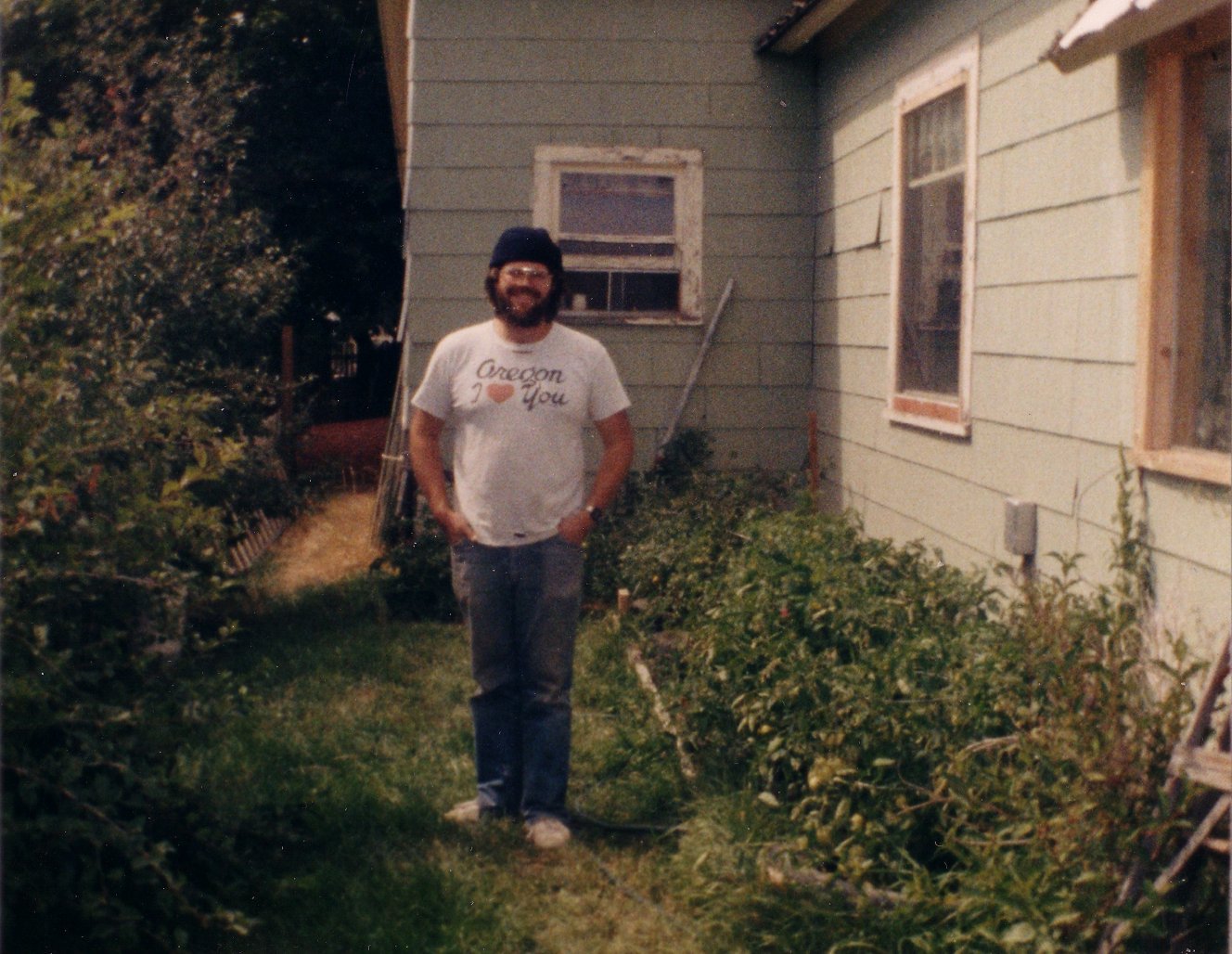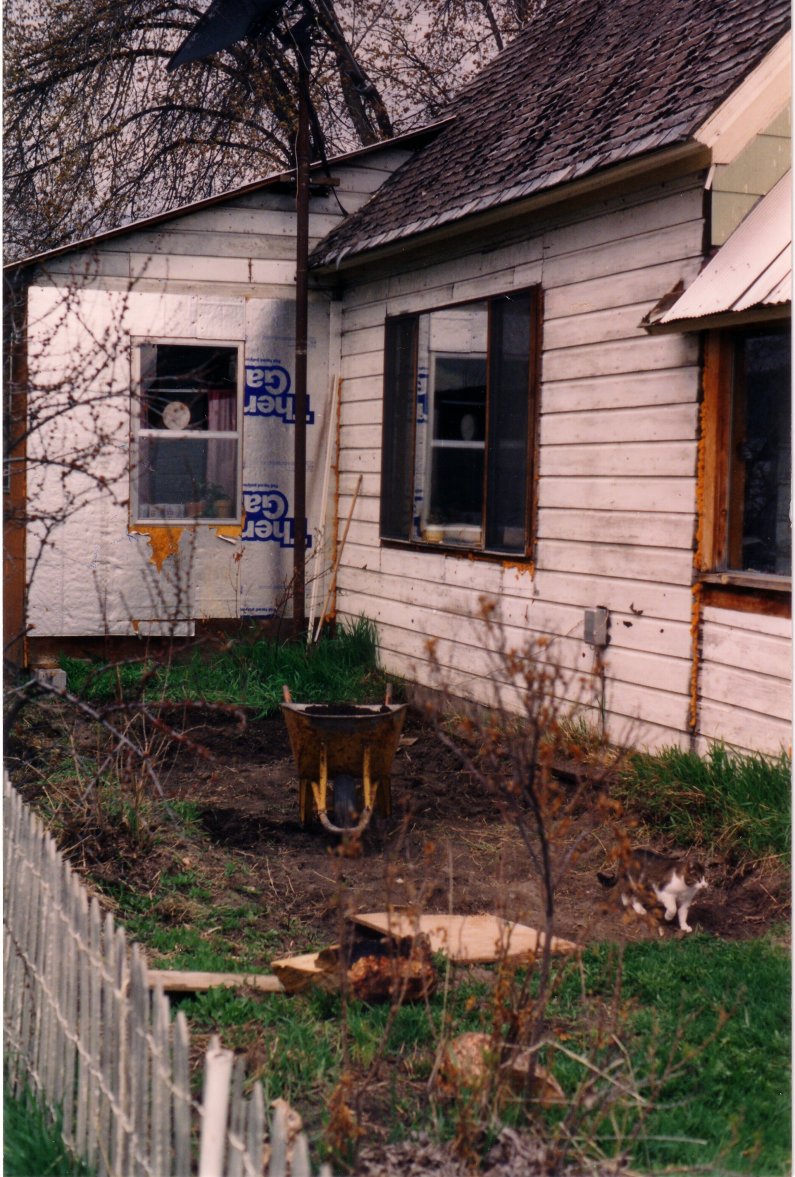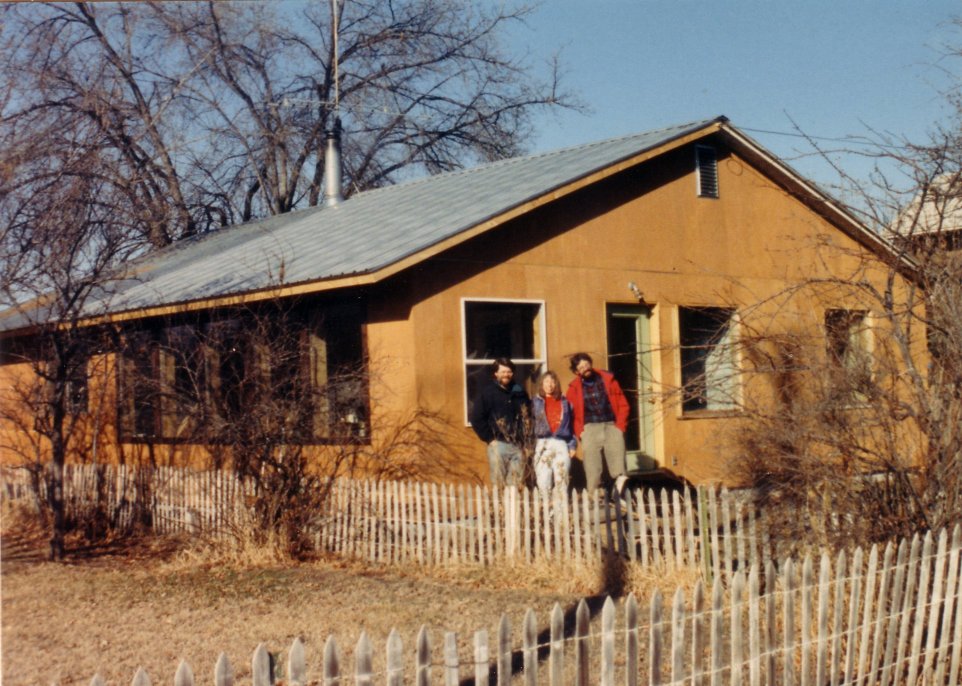Dirt First!
(Grassroots Activation in the 21st Century)
by Barry Carter
Created:
Modified:
How
I learned about soil problems
I planted my first organic garden, in the back yard of the first house I
rented, in the summer of 1969. This was also my first experience with seriously
compacted and depleted soil. The previous tenants of this house had used the
back yard as a place to park their cars and burn/dispose of garbage. When I
hand tilled the soil, I also dug up pieces of broken glass, tin cans and old
door knobs. I grew a lot of vegies in this garden but I was a bit disappointed
that they did not look and taste as good as the organic food I got at my mom's
health food store.
Back then I did not fully realize that soil is home to an incredible web of
life and that it is the foundation of the ecosystem.
On
Throughout the seventies I lived in several places and generally started a
garden in the yard. Some of these gardens started with compacted soil and poor
results but they all improved over time through the use of compost.
In the fall of 1983, I moved into the house I
live in now. My wife and I planted a small garden on the south side of the
house in 1984 and she took a picture of me standing next to it in the summer of
1985:

When I dug this garden up to put in the foundation for a greenhouse addition, I
noticed that the soil in the garden area was much less compacted than the soil
under the lawn I was standing on in the picture above. Below is a picture that
I took during this excavation:

Here is a picture of my house after the greenhouse addition was done:

In the mid eighties I started doing a bit of environmental activism when a
copper “recycler” proposed building a plant to incinerate and
recover the copper from electric transformers which were filled with PCB oil.
We opposed this incinerator because of the definite air quality problems that
it would pose. We stopped this from happening.
In the mid eighties my wife and I attended a couple of the annual Round River
Rendezvous put on by the radical environmental group Earth First!. At one of these gatherings I attended a group discussion
of the role of soil in the ecosystem. This is where I first heard the term
"dirt first!".
In 1988, I began working full time as a forest activist. In this work, I became
even more aware of the problems that were being created by loss of topsoil,
soil compaction and loss of soil nutrients. In 1995 at the Public Interest
Environmental Law Conference at the University of
Oregon Law School in
http://www.fromthewilderness.com/free/ww3/100303_eating_oil.html
In the late eighties and early nineties, I was involved with the formation of a
couple of local environmental groups which we started in response to the
transformer incinerator plan and other challenges to our local environment.
Eventually I began appealing and litigating logging, mining and grazing on
public lands. In April of 1994 I set up a BBS for environmental activists who
did not have internet access. Here is something I wrote to this BBS about soils
on
I talked to Elaine Ingham the other day and she is
interested in the Alliance BBS as well.
Some things that Elaine Ingham mentioned in her talk at the Natural Resources
Institute suggested that most of the biomass of a given forest system is below
ground in the form of bacteria, fungi, nematodes and arthropods.
Elaine Ingham suggests that nitrogen fertilizer may not be well assimilated by
forest ecosystems in the latest issue of Natural Resource News (January 1995).
She says:
"Among
factors that keep plants from growing at their maximum potential rate, nitrogen
is usually the limiting factor. Especially in forests, nitrogen limitation, not
light limitation, is what restricts productivity. For sub-dominant canopy
trees, light may be the current limitation, but it is quite probably that
competition for nutrients from the soil initiated that sub-dominant tree's
inability to compete for light.
Is the suggestion then to spread tons of chemical fertilizer on forest stands?
This is not a reasonable solution. First, spreading fertilizer throughout
forests of the
If we understand nutrient cycles in the soil, and work to enhance those
processes that are beneficial to the vegetation human beings want on that land,
we can enhance and encourage nutrient availability for the plants we desire
during the time of year those plants require massive amounts of nutrients. We
can enhance and encourage nutrient retention in soils, during those times the
plants we desire in the system don't need those nutrients. Instead of fighting
the complex soils system that has developed through eons of time, we need to
learn what is present in soil, and how to manage those organisms. Instead of
destroying nutrient cycling processes and the organisms that perform those
processes for us, we need to sustain them."
Elaine Ingham also talks about the effects of chemical herbicides on
underground species:
"Most
conifers are obligately mycorrhizal; conifers can be grown in hydroponic
systems without mycorrhizae, but when they must compete with other plants for
nutrients, conifers such as Douglas-fir, ponderosa pine, or lodgepole, won't
survive without the mycorrhizal fungi growing on their root systems.
This mycorrhizal network is destroyed when soil is compacted with large
machinery, and mat-forming mycorrhizal fungi are destroyed when forests are
clearcut. A number of pesticides, including some herbicides, kill these
fungi." . . . "One of the major functions of decomposer fungi and
bacteria in soil is to retain nutrients in the soil when it rains. If applied
pesticides kill bacteria, the nutrient-retaining ability of that soil is
reduced. If fertilizers are applied that select for bacteria instead of fungi
in forests, fungi can be outcompeted, soil pH can be increased, soil
aggregation can be altered, and the forest can be lost. The ratio of fungal to
bacterial biomass is critical. In an experiment performed with sterilized
short-grass prairie soil, just the bacterial community or just the fungal
community (Table 1) was added back to that soil. Addition of bacteria resulted
in alkaline pH and nitrate as the dominant form of N in that soil. If fungi
were added, the pH of the soil became more acid and ammonium became the
dominant form of N. Thus, in forest soils, we must maintain a fungal dominance
in order to maintain favorable environment for the trees. If bacteria become
the dominant form of soil decomposer, grasses are selected and the forest can
be lost."
More on fungi and soils can be found at:
http://www.subtleenergies.com/ormus/tw/fungi.htm
Soil compaction from the heavy equipment is another major problem. This
compaction may be due in the largest part to the vibration of the equipment
transmitted through the soil rather than direct compaction from the weight of
the equipment wheels or tracks on the skid trails. Compacted soil favors
anaerobic bacteria rather then the aerobic mycorrhizal fungi that are so
crucial to soil health and long-term site "productivity". See how the
soil food web can be damaged by compaction and other factors at:
http://www.rain.org/~sals/ingham.html
In January of 1995 I wrote the document linked below as comments on a fire
salvage timber sale:
http://www.subtleenergies.com/ormus/bmnfa/Soilcmts.htm
On
In
the past 80 years we have lost half of the world's topsoil. We cannot do this
ever again and continue to feed anyone.
In this email I also included the following from a document by EarthSave
International (http://www.jivdaya.org/what_beef_who_pays.htm):
An
inch of topsoil takes between 200 and 1,000 years to form under natural
conditions.
The direct and indirect costs of soil erosion and runoff in
the
Topsoil depletion has been the cause for the demise of many great
civilizations.
All of the above describes the problems associated with soil damage and loss.
Now, here are some solutions.
How I learned about soil solutions
In February of 2002 I learned about terra preta from a post on a biodynamic
forum:
"According
to William I. Woods, a soil geographer at Southern Illinois University,
ecologist's claims about terrible Amazonian land were based on very little
data. In the late 1990's Woods and others began careful measurements in the
lower Amazon. They indeed found lots of inhospitable terrain. But they also
discovered swaths of "terra preta" --rich, fertile "black
earth" that anthropologists increasingly believe was created by human
beings."
Since then I have maintained an interest as more and more people have become
involved with building soil using terra preta (now more widely known as
biochar). When I learned about biochar I realized that it may have contributed
to the fertility of the soil in areas where I
burned leaves and branches in my past gardens.
In March of 2010 I was contacted by a microbiologist named Douglas Beitler who
has a web site which promotes biochar products:
http://www.charbiological.com/
On
"The solution to global warming is very simple and cheap, soil
sequestration." and "... a 1.6% increase in organic content of soils
humans manage would restore atmospheric carbon dioxide levels to normal."
These quotes were from a video and web page by an Australian farmer named Allan
Yeomans:
http://www.youtube.com/user/AllanYeomans1#p/a/u/0/-o2N6vJDLpE
Allan Yeomans also has a book online at:
http://www.yeomansplow.com.au/priority-one-contents.htm
The use of the plow that Allan Yeomans and his father developed is called
"keyline plowing". It actually tills the subsoil more than the
topsoil. One farmer has reported eight inches of new soil depth in one year
with the use of keyline plowing combined with concentrated sea minerals:
http://www.subtleenergies.com/ormus/tw/topsoil.htm
At:
http://www.youtube.com/watch?v=oDMg6W95-2s
You can find the first of a twenty one part video presentation by Darren
Doherty titled: "Rx for the Biosphere". This is an excellent series
on the importance of using Keyline plowing and other techniques to increase
carbon sequestration while promoting soil organic matter and water holding
capacity of the landscape.
Darren Doherty also mentions the work of Carbon Farmers of America. See:
http://www.subtleenergies.com/ormus/tw/topsoil.htm
These guys also advocate soil organic matter "SOM". When I was
lecturing in Australia in November of 2008, Rob Gourlay, an environmental
scientist and founder of the Environmental Research & Information
Consortium (ERIC) told us about how he has been combining Effective
Microorganisms (EM) and these sea minerals in some of the ERIC products and
Australian farmers have started asking him "where is all the water coming
from?" after using this product:
http://eric.com.au/html/papers_soilmap.php
In addition to using the Yeomans plow for subsoil tilling, the best way I know
of to sequester carbon in soil is to use a sea mineral supplement, with reduced
salt. This mineral supplement can be made by anyone with access to lye and sea
water using the following method:
Take sea water or whole sea salt, dissolved in water, and raise its pH to 10.78
using lye (also known as caustic soda or sodium hydroxide) to precipitate out
these beneficial minerals.
This mineral precipitate is typically applied at the rate of one to three
gallons per acre (ten to thirty one liters per hectare). This is usually
applied just once a year for most row crops but will be after each harvest for
grains and other crops which get multiple cuttings per year. I have purchased
lye for about four dollars per pound. One pound of lye will produce about ten
gallons of precipitate from fifty gallons of ocean water. This means that
anyone with access to ocean water and lye could apply this for less than two
dollars per acre.
I first learned about these minerals in 1995 when I attended a lecture by an
My first encounter with plant benefits resulting from the application of these sea minerals was in October of 2000. I
documented the increased growth of a walnut tree in north central
http://www.subtleenergies.com/ormus/tw/walnuts.htm
Here is an example of one test showing increased soil carbon resulting from the
application of these minerals:
Wheat
was germinated in soil tests and grown out for 20 days before analysis of the
soil. The soil was then sent to an independent soils laboratory for
quantitative testing of total bacterial biomass and total fungal biomass.
The control sample received no fertilizer or treatment with sea minerals. This
sample was used to establish a baseline.
A second test sample received a complete fertilizer and no sea minerals.
The third sample received the complete fertilizer and treatment with sea
minerals at the rate of one gallon per acre.
|
|
Total Bacterial Biomass |
Total Fungal Biomass |
|
Baseline |
872 |
547 |
|
Fertilizer only |
1,183 |
692 |
|
1,282 |
1,075 |
These
sea minerals when used with fertilizer increased the total bacterial biomass by
47% over the baseline. Fertilizer alone only increased the total bacterial
biomass by 36%.
These sea mineral when used with fertilizer increased the total fungal biomass
by 97% over the baseline. Fertilizer alone only increased the total fungal
biomass by 27%.
This is a total increase in fungal plus bacterial biomass of over 66% in only
twenty days.
We should also add the increase in plant root biomass as a result of increased
availability of nutrients due to increased fungal and bacterial activity.
Several tests have been done with these sea minerals on various plants but most
of these tests were longer than 20 days. For example, the increase in dry root
mass of corn was 65.22% after 115 days of growth using these minerals along
with N-P-K fertilizer (which was used on the control crop too). The dry matter
root mass of purple basil increased by 325.25% in only 30 days!
The tests above were done by the following supplier of these sea minerals and I
am using the data with their permission:
http://www.sea-crop.com/
Other providers of these (and similar) minerals are linked at:
http://www.subtleenergies.com/ormus/tw/sources.htm#2
According to:
http://soils.usda.gov/sqi/concepts/soil_biology/soil_food_web.html
only about 5% of soil organic matter is alive. If we could double this in a
year or two, it would also increase the dead organic matter over time.
My personal experience with these minerals is that their benefits accumulate
over time and I have seen about a five-fold increase in the mass/production of
my plum tree over a five year period:
http://www.subtleenergies.com/ormus/tw/plums.htm
http://www.subtleenergies.com/ormus/tw/Plums_2010.htm
I have placed a video description of how these plums taste at:
http://www.subtleenergies.com/ormus/tw/PlumTasty.wmv
Other plant and soil results, from the use of these minerals, are linked at:
http://www.subtleenergies.com/plant-lynx.htm
I'm convince that the very low application rate and the open source methods for
concentrating these sea minerals make them the ideal way to sequester more
carbon in the soil and that this is the cheapest and easiest way to pull
greenhouse gasses out of the atmosphere.